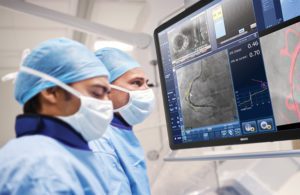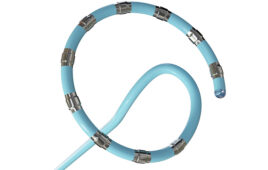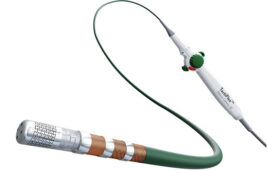Philips is betting on the latest technology in image-guided catheters to advance cardiology.

Interventional cardiologists use an IVUS catheter system in the OR. [Image courtesy of Philips Image Guided Therapy.]
The latest in percutaneous coronary intervention aims to improve minimally invasive image guidance by providing real-time guidance using intravascular imaging, fractional flow reserve (FFR) and instantaneous wave-free ratio (iFR) and similar indices. Companies in this sector are also aiming to improve image resolution and introduce tools such as image co-registration, said Andrew Tochterman, coronary segment leader at Philips Image Guided Therapy.
A percutaneous coronary intervention (PCI) starts with an angiogram, said Tochterman, but from there it takes multiple pieces of information and equipment. “Getting it right for the patient is the ability to bring together all the relevant information to localize and personalize treatment.”
Here’s how Philips officials are seeking to achieve their goal:
- Improving catheter flexibility. With intravascular imaging, success starts with a flexible catheter. “The arterial pathways are tortuous, so the catheter can’t be rigid,” said Tochterman.
- Taking advantage of miniaturization technology. Tochterman noted that further miniaturization will play a big role in improving the resolution of the technology. He said Philips spends a lot of its energy on intravascular ultrasound (IVUS) and catheters overall, with the goal of helping clinicians better decide, guide and confirm the right treatment. In an IVUS catheter, a transducer emits high-frequency sound waves that echo off vessel walls. These are sent back to the system in varying intensities depending on the tissue. System electronics process the signal to display the cross-sectional image. Philips’ technology has a miniature transducer as a tiny dot array around the catheter tip. “That innovation allowed us to get away from having a drive train and transducer spinning inside the artery, and we’re able to send pulses out to the artery in a circumferential pattern to collect the information at once,” Tochterman said.
- Using hard data to empower surgical decision-making. The pressure and flow sensing technology allows interventionalists to rely less on the angiogram and use hard numbers to make decisions for treatment – something the angiogram has a hard time doing. “Interventional X-ray systems take an outside-in view — it looks at the silhouette of the arteries,” Tochterman said. IVUS catheters look at the makeup of the vessel lining, and the medial layers to best determine if the artery is calcified or fibrotic, for example. Based on that information, the interventionalist can determine the risk profile of the patient, and better chart a course for success. For example, with a calcified artery the interventionalist might choose atherectomy or scoring balloons, also offered by Philips, which may be different interventional tools than with a thrombus or plaque rich environment.
Beyond today’s technology, Tochterman said Philips and other companies are looking at how AI and machine learning will play a role in helping interventional cardiology advance. “We’re in those very early days of artificial intelligence. I think it will be very disruptive, but in a really positive way for the healthcare system and most importantly, for patients.”
Tochterman compared the technology to cell phones. “We knew that cell phones would be important, but very few of us probably predicted just how central they would be in our lives just 15-20 years later.” Along the same vein, he can’t yet predict exactly how AI will transform the therapeutic space in 10 to 15 years, but noted that it will improve personalization and specificity of treatments. Tochterman said Philips, like its competitors, is very committed to the space. “We’re very excited about the potential of AI overall. It’s going to be a big shift and we don’t know how it will play out in the long-term, but it will be a shift that benefits patients and clinicians.”
Overall, the objective is to bring information together, to aid in more efficient decision making. The iFR/FFR technology and the imaging technology we produce is very useful, but it takes interventionalists away from what they were trained on, the angiogram. Doctors see the value of the information and want to use it, but to do so they have to look at two different screens, mentally mark that information and then piece it together as they look back at the angiogram. Tochterman explained. Technologies like Philips’ co-registration platform take the iFR/FFR data, and imaging data and overlay it onto the angiogram to aid in interpretation. “It is such an obvious thing to do to provide seamless, integrated information. And we want to be the ones to do more of it.”




